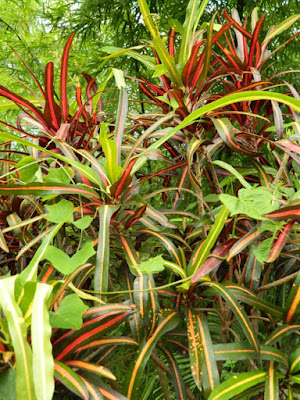Or "The Trouble with common names for plants"
Chinese New Year 2016 edition is just around the corner beginning on February 8 so, firstly, let me wish you all a very lucky and healthy Year of the Monkey! I'm a Snake and apparently we (me and other Snakes) will have a good 2016 with lots of money, romance, and good health. Snakes (under the Chinese zodiac), however, are naturally suspicious and rightly so since it's the same forecast every year!
My wife, Linda, asked me to identify this plant below, whose stalks make up the the "good luck" floral arrangement she received for Chinese New Year and I was completely stumped/stalked.
I've never seen fruits like these before and I first thought they were fake balloons! I then was informed by Mr. Google that they were nipplefruits or Solanum mammosum.
 |
| Solanum mammosum (Nipple fruit) in a floral arrangement |
Leading up to Chinese New Year eve, which varies every year since it's based on the lunar calendar, there's a frenzy of red, gold and orange if you visit your local Chinatown.I find it's a wonderful time, a riot of colour leading up to one of the most important days for many East Asians. I'll never forget the sights, sounds and scents Linda and I experienced in Hong Kong when we made an improbable visit in January 2000 right before our first daughter was born in August.
You'll see kumquats, Chinese mandarins and pomelos on sale as separate fruits or potted plants in many Chinese grocery stores right about now. We have a few mandarins (always with the green leaves and stalks attached to "ensure" evergreen longevity and over good mojo) ready when we pay respects to our ancestors and whatever gods we're specifically trying to appease/curry favour over the next 12 months. Whether or not we actually have good fortune over the next year isn't too important for me (one still has to work hard) but having the mandarins makes my mom happy. And if she's happy, it's more likely my kids and her other grandsons and grand-daughters will get a bigger lucky money envelope! Seriously, though, it's a time for families to come together and getting lucky money is a small but fun part of the night.
Getting pure gold-coloured fruit plants and arrangements is hard enough so orange is an acceptable replacement; hence, the presence of nipplefruit arrangements at this time of the year. There's further significance with nipplefruit in Chinese households and businesses as the plant's name is written as "Five Generations in Harmony" according to Linda (whose Cantonese is a hell of lot better than mine!) Basically, you're wishing the recipient of your floral arrangement lots and lots of sons, wealth and longevity which is still a big deal, I guess, in China and many other places. Symbolism with plants, especially flowers, crosses cultures, which I always find interesting.
The plant itself is a shrub native to South America, has hairy leaves with spines and purple "nightshade-like" flowers. The fruits are poisonous (no surprise as Solanum mammosum is in the Solanacae family which includes lethal beauties like Brugmansia, Datura and Nicotiana.)
 |
| Nipple fruit (Solanum mammosum) |
Here's a closeup of said fruits with said nipples. They feel smooth (clean thoughts now) and reminded me of persimmons. Other common names for this plant, besides nipplefruit, include cow's udder, pigface, zombie apple, titty fruit and, my favourite, "Apple of Sodom". You can really impress your friends by reciting these facts but please don't come across too much of a plant nerd.
In Japan, it's called "fox face" and "fox eggplant" after being translated into English. I thought being called an eggplant could be problematic if they are ingested in error.
Ah, the perils by using common names!



















































